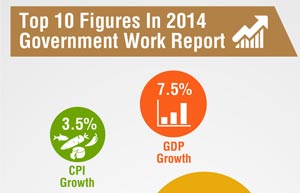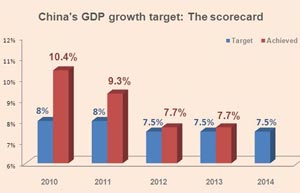Looking to a promising future
By Xu Hongcai (China Daily) Updated: 2014-03-15 08:03Chinese economy faces potential risks but strong fundamentals will ensure that it sails unscathed through troubled waters
Contrary to some foreign experts' views that the Chinese economy may encounter "big trouble" in 2014, it is likely to register a 7.5 percent growth. One of the main reasons for that is the rapidly changing demand structure in China in which consumption plays a much greater part.
China's economic growth used to be driven by investment and exports. But that no longer is the case. For example, last year consumption contributed 50.4 percent to the country's GDP, while exports contributed minus 4.4 percent, according to the National Bureau of Statistics. With the increase in people's income this year, the contribution of consumption will continue to rise. External demand is also expected to increase with the economic recovery in the United States and the European Union.
China's economic supply structure, too, has undergone change. The transformation of the industrial structure has boosted economic growth, with the service sector's expansion offsetting the weakening of the manufacturing industry. In 2013, the value-added services of the service sector accounted for 46.1 percent of China's GDP, exceeding the proportion of value-added products of the manufacturing industry for the first time.
With the gradual decline in household savings rate, the economic contribution of capital and labor to GDP will decrease, while technical progress and human capital will contribute more to the economy. So the development of the service sector, especially producer services, can help increase its contribution to economic growth.
Moreover, the new urbanization plan offers China new opportunities. An increasing number of farmers are turning into urban residents, prompting local governments to increase investment in infrastructure. This will strengthen the public transport system, including railways, and other public facilities, which, in turn, will improve the lifestyle and consumption of the farmers-turned-urban residents.
Besides, the regional economic disparity in China can extend its rapid economic growth cycle. With the labor and production costs rising in eastern China, some industries are gradually shifting to the central and western regions. In particular, the development of cross-regional economic belts linked by the big rivers and traffic arteries, like the modern Silk Road and the Yangtze River Economic Zone, have expanded China's economic development space.
Also, the bonus of the reform and opening-up will continue to benefit the economy. In fact, as 2014 is the first year of deepening reform, the country's leadership will take various measures to achieve steady progress, create new development opportunities and stave off potential risks.
It is generally regarded that the Chinese economy faces four potential risks-local government debt, real estate bubble, shadow banking and the repercussions of tapering of quantitative easing (QE) by the US Federal Reserve. But since the overall risk facing the economy is not high, there is little possibility of China encountering a financial crisis.
|
 |
 |
- NHTSA says finds no 'defect trend' in Tesla Model S sedans
- WTO rare earth ruling is unfair
- Amway says 2014 China sales may grow 8%
- President Xi in Europe: Forging deals, boosting business
- CNOOC releases 2013 sustainability report
- Local production by Chery Jaguar Land Rover this year
- Car lovers test their need for speed in BMW Mission 3
- China stocks close mixed Monday

















